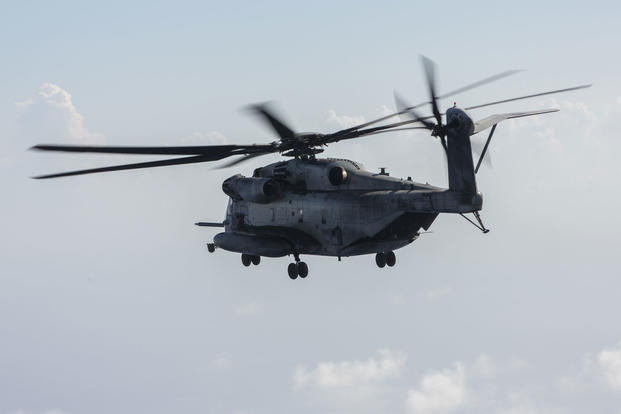All Marine Corps CH-53E Super Stallion heavy-lift helicopters based in Okinawa, Japan, will pause operations for 96 hours after one of the aircraft caught fire Wednesday and was forced to make an emergency landing.
The commanding general of III Marine Expeditionary Force, Lt. Gen. Lawrence Nicholson, ordered the pause Thursday morning.
The pause likely affects a relatively small number of aircraft; Marine Corps Air Station Futenma does not have its own heavy-lift helicopter squadron.
But CH-53s with Marine Heavy Helicopter Squadron 462, out of Marine Corps Air Station Miramar, California, are currently in Japan as part of the service's rotational unit deployment program.
"We will conduct a thorough investigation working closely with aircrew and maintenance experts to determine the cause of the incident," III MEF officials said in a statement. "We will continue to share information with the government of Japan as details become available, while understanding that the investigation must be protected and cannot be released until complete."
Officials said Marines in Japan continue to work with local agencies to clean up the crash site and remove the aircraft.
An initial survey, they said, is underway to choose the best way to move the helicopter while minimizing damage to the surrounding environment.
The aircraft went down in a field near Okinawa's Northern Training Area. None of the Marine crew members was injured in the crash, but the damage to the aircraft itself is unclear.
While officials said no civilians were hurt, Nicholson noted that Okinawan property had been damaged when the aircraft went down.
"This is a regrettable incident, and after the investigation is complete, those with property damage as a result of this incident will be appropriately compensated," he said in a statement.
"I want to thank the local Japanese first responders who helped secure the scene quickly and safely, the members of 33rd Rescue Squadron who evacuated our crew members, and those moving the aircraft safely today," Nicholson said.
"I also want to thank everyone for the concern shown for our pilots, the local community members, and their understanding of the risks both Japanese and U.S. military men and women take daily as part of our vital responsibility to provide for the defense of Japan," he continued.
The workhorse CH-53 is one of the Corps' most combat-worn aviation platforms and is rapidly reaching the end of its service life, with its successor -- the CH-53K King Stallion -- expected to begin joining squadrons as soon as next year.
A recapitalization effort begun several years ago has endeavored to keep Super Stallions flight-worthy in the meantime.
But in March 2016, Marine Corps Commandant Gen. Robert Neller acknowledged the service "probably kept [CH-53s] in theater a little bit too long" during the wars in Afghanistan and Iraq, which took a toll on their condition.
-- Hope Hodge Seck can be reached at hope.seck@military.com. Follow her on Twitter at @HopeSeck.



























